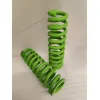Your Position: Home - Automobiles Motorcycles - What Every Technician Needs to Know About Coil Springs
Coil springs play a crucial role in various mechanical systems, from automotive suspensions to industrial machinery. Technicians dealing with these components should possess a foundational understanding of their design, functions, and common considerations. Here's what every technician needs to know about coil springs:
1. Basics of Coil Spring Design:
Wire Diameter: The thickness of the spring wire.
Outer Diameter (OD): The overall diameter of the coil.
Inner Diameter (ID): The diameter of the central opening within the coil.
Active Coils: The number of coils that contribute to the spring's deflection.
2. Materials Used:
High Carbon Steel: Commonly used for its durability and cost-effectiveness.
Stainless Steel: Resistant to corrosion, suitable for applications in harsh environments.
Alloys: Offer specific performance characteristics, catering to diverse applications.
3. Load and Compression:
Load Capacity: The maximum force a coil spring can endure without permanent deformation.
Compression: The spring's ability to compress and return to its original shape under an applied load.
4. Types of Coil Springs:
Compression Springs: Absorb and store energy when compressed.
Extension Springs: Absorb and store energy when stretched.
Torsion Springs: Store energy when twisted or torqued.

5. Spring Rate and Stiffness:
Spring Rate (k): The amount of force required to compress or extend the spring by a unit distance.
Stiffness: A measure of how resistant the spring is to deformation.
6. Dynamic and Static Loading:
Suggested reading:Dynamic Loading: Springs subjected to varying loads during operation.
Static Loading: Constant or unchanging loads on the spring.
7. Environmental Considerations:
Corrosion Resistance: Essential for applications exposed to moisture or corrosive substances.
Temperature Sensitivity: Some materials may exhibit changes in performance under extreme temperatures.
8. Common Failure Modes:
Fatigue: Gradual wear and failure due to repeated loading and unloading cycles.
Overloading: Exceeding the spring's load capacity, leading to permanent deformation.
Corrosion: Deterioration of the spring material due to exposure to corrosive elements.
9. Installation and Maintenance:
Proper Installation: Ensures correct alignment and functioning within the system.
Regular Inspection: Detects signs of wear, corrosion, or fatigue, allowing for timely replacement.
10. Applications Across Industries:
Automotive: Suspension systems, shock absorbers.
Manufacturing: Machinery, industrial equipment.
Aerospace: Landing gear, control systems.
11. Safety Considerations:
Potential Energy Release: Exercise caution when handling compressed coil springs.
Proper Equipment: Use appropriate tools and equipment for installation and removal.
By mastering these fundamental aspects of coil springs, technicians can troubleshoot, maintain, and optimize systems where these components are integral. A solid understanding of coil springs is essential for ensuring safety, longevity, and optimal performance in various technical applications.
58
0
0
Comments
All Comments (0)
Related Articles
Car Mat: Enhance Your Driving Experience with Premium Comfort and Protection
When it comes to optimizing your driving experience, a high-quality car mat is an essential accessory that often goes overlooked. Car mats not only provide a comfortable and clean surface for your feet but also offer protection to your vehicle's interior.
By May
153
0
0
Factors Affecting the Performance of Commercial Vehicle Brake Pads
The performance of commercial vehicle brake pads plays a critical role in ensuring safe and effective braking. Several factors can influence the performance of these brake pads. Understanding these factors is essential for maintaining optimal braking performance and ensuring the safety of commercial vehicles.
By May
153
0
0
Advantages and Benefits of Electric Trucks
Electric trucks have gained significant attention and popularity in recent years as an alternative to traditional diesel-powered trucks. They offer numerous advantages and benefits that make them an attractive option for businesses and fleet operators.
By May
153
0
0
Understanding Cylinder Head Damage: Causes and Consequences
The cylinder head, being a crucial component of an internal combustion engine, is susceptible to various forms of damage. This article aims to provide a comprehensive understanding of why cylinder head damage occurs, exploring its causes and the potential consequences that can arise.
By Hou
146
0
0
Ceramic vs. Metallic Brake Pads: Which is Best for Your Vehicle?
When it comes to maintaining the safety and performance of your vehicle, one crucial component to consider is the brake system. Brake pads play a vital role in stopping your vehicle effectively, and choosing the right type of brake pads can greatly impact your driving experience.
By July
147
0
0
How do I know if my coil springs are bad?
Coil springs are vital components of a vehicle's suspension system, providing support, stability, and a smooth ride. Over time, however, coil springs can wear out or become damaged due to various factors. Recognizing the signs of bad coil springs is crucial for maintaining the safety and performance of your vehicle.
By July
143
0
0
How a Radiator Works in a Truck
A radiator is a crucial component of a truck's cooling system. Its primary function is to dissipate the heat generated by the engine during combustion and prevent the engine from overheating. The cooling system in a truck plays a vital role in maintaining the engine's operating temperature within the optimal range for efficient performance
By July
147
0
0
How Much Does it Cost to Replace a Radiator?
The radiator is an integral component of a vehicle's cooling system, responsible for transferring heat away from the engine and preventing it from overheating. However, over time, radiators can become worn, damaged, or develop leaks, requiring replacement. If you find yourself in need of a new radiator for your passenger car, it's essential to understand the potential costs involved in this process.
By Hou
106
0
0